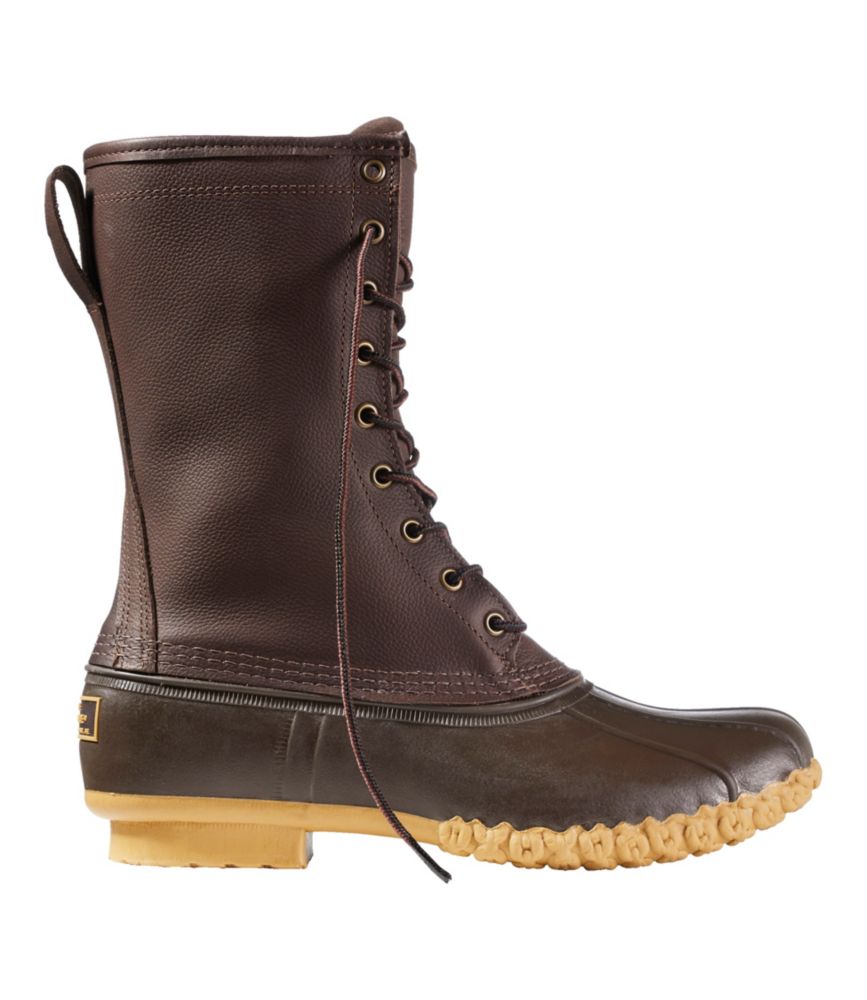Men’s Maine Hunting Shoes, 10″ Gore-Tex/Thinsulate
The original L.L.Bean Boot, made in Maine since 1912. Now with even more protection from cold, wet weather, with a waterproof Gore-Tex liner and warm Thinsulate insulation.
The original L.L.Bean Boot, made in Maine since 1912. Now with even more protection from cold, wet weather, with a waterproof Gore-Tex liner and warm Thinsulate insulation.
Size & Fit
- With light or midweight socks: Whole sizes, order your normal size. Half sizes, order one size down. Example: 9 or 9½, order a size 9.
- With heavyweight socks: Whole sizes, order one size up. Half sizes, order one size up. Example: 9 or 9½, order a size 10.
- Half sizes order down.
Specs
- Approx. weight: 3 lb. 12 oz. per pair.
Construction
- Premium waterproof leather upper.
- Waterproof, breathable Gore-Tex liner.
- 200-gram Thinsulate® olefin/polyester insulation.
- Steel shank in the arch, for added lateral support.
- Rubber, matte finish sole with chain tread pattern.
- Leather pull-on loop at back collar.
Additional Features
- Handstitched and checked for quality right here in Brunswick, Maine.
Additional information
| Approx. weight | 3 lb. 12 oz. per pair. |
|---|


by Pony
i have had my hunting boots for about ten years now! i also use them for the snowblower there still warm and where toasty warm in 51 below weather! need a pair of boots? check this out this boot beats my kaufman boots at half the price!!!!!!!!! boot guard works fine.
by Navy
I am a woman that wears size 9.5 women's in all my shoes. I always buy shoes that have a more natural shape toebox. Because of that I find a lot of women's winter boots on the narrow side. I bought these men's sz 8 in d width. I think they are just a little long. Width is good. I have a low volume foot so there is extra room above my foot. However, room equals warmth. I find them toasty. Perhaps a beefier innersole will resolve.
Great for snow blowing or shoveling. A bit too clunky for general walking with that extra space. Great quality shoe. Expect to get many yrs use. Would loved to have bought/ tried both 7's n 8's, but that is expensive and returns get complicated that way as I wanted to apply my Bean bucks to only the pair I was keeping. Not split it.
by Folly
I purchased this boot for hunting/hiking in Northeast Minnesota. It is extremely light, waterproof and very comfortable to wear. Customer service was outstanding when I called with questions regarding size. I normally wear a 10.5 shoe and Size 11 winter boot (sorels etc). I was advised to order a size 10 and it fit perfect. So order one size down from your winter boot. Boots are very well made and held up well this fall as I put 15 miles on them (at least) through the brush and swamps. Boots are very warm, but not a boot you would wear for a cold morning sit in a deer stand. HIGHLY Recommend this boot – Great job LL Bean! Very pleased with your products and service!
by Dave
These boots are super! I take size 9.5 so I ordered 9 as recommended. With Bean’s heavy socks, they fit perfectly. They are comfortable, warm, and have good support. I added a coat of Bean’s boot guard for added weather protection. I highly recommend these. Maine’s motto is “The way life should be”. Perhaps LL Bean’s motto should be “The way boots should be made”.
by Guido
I bought these 10 years ago to primarily hunt upland game. They are truly the most comfortable and dry boot that I have worn. In February 2020 I sent them in to be resoled and a new set of liners added, what an impressive job! I received them back with new rubber bottoms, new removable liners, new removable foot cushions and new laces. They are like brand new boots with broken-in leather uppers. I also utilize the LL Bean sherpa foot liners for colder weather, they are a real game changer in the colder weather/snow. There is not one thing negative that I could say about these and I have recommended them to others.